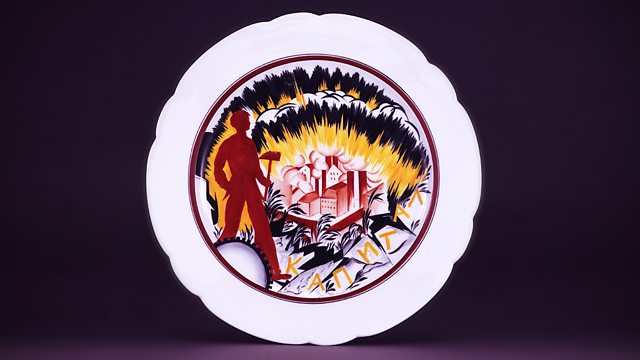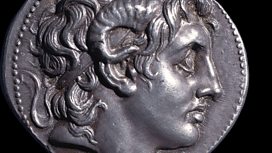Russian revolutionary plate
Neil MacGregor is exploring the political landscape of the 20th century. Today he is with a plate decorated during the Russian revolution
Neil MacGregor's history of the world as told through things that time has left behind. Throughout this closing week he is examining some of the major social and political movements that have helped shape our contemporary landscape. Today he tells the remarkable story of a Russian plate. It was made in 1901 in the Imperial Porcelain Factory in St Petersburg. Twenty years later it was painted over as a propaganda tool for the new Communist Revolution - decorated in the same factory that had become the State Porcelain Factory and in a city renamed as Petrograd. The director of the State Hermitage Museum in St Petersburg, Mikhail Piotrovsky, and the great historian of modern Russia, Eric Hobsbawn, help piece together this momentous history.
Producer: Anthony Denselow
Last on
More episodes
Previous
You are at the first episode
![]()
More programmes from A History of the World in 100 Objects related to leaders & government
About this object
Location: St. Petersburg, Russia
Culture: The Modern World
Period: 1921
Material: Ceramic and Paint
��
This plate depicts a worker trampling the word 'Kapital' (capitalism), to release the dynamic forces of a new industrial order for the benefit of the workers. The plate was created to celebrate the Russian Revolution of 1917 and the creation of the world's first Communist state. The whole image is in the Futurist style favoured by the artists of the Revolution. It was designed by Mikhail Mikhailovich Adamovich (1884 - 1947) and created in the State Porcelain Factory in Petrograd, previously named St Petersburg.
How was porcelain used to spread propaganda about the Russian Revolution?
The former Imperial Porcelain Factory, founded in 1744, worked exclusively for the Russian Royal Family and Imperial Court. After the Russian Revolution of 1917 the factory was renamed the State Porcelain Factory. Existing stocks of plates produced before the Revolution, but not yet decorated, were painted with the symbols and slogans of the new Soviet republic. This plate was made in 1901 under Tsar Nicholas II, but decorated in 1921. Many such plates were exported abroad, demonstrating how luxury objects from the Tsar's own factory could symbolize the overthrow of the capitalist system.
Did you know?
- After Communism in the USSR collapsed, the factory that made this was privatised and renamed: Imperial Porcelain factory.
Revolution!
By Eric Hobsbawm, historian and author
��
Well there was no great surprise about a revolution in Russia, there had been one in 1905 – rather sort of European type, getting parliament and so on – but basically the country was backward, poor, unstable and in fact it was not likely to survive a major war. And in fact it was the war, the Great War, which did for the Tsar. Essentially it was a revolution not against the Tsar, as against the war. And it is when the soldiers joined the rather hungry workers in Petrograd, and occupied the cities and did not shoot the workers – as the Tsar would have wanted to – that it became clear that the Tsar had to go, and he resigned shortly afterwards.
The mood was one of complete chaos, in a way, in which the workers, and even the peasants and the soldiers, started organising their own councils while a provisional government was formed. But the provisional government had virtually no independent power, particularly not because it insisted on going on with the war. And when it insisted on going on with the war, in fact increasingly both the soldiers and the peasants and the workers became radicalised. The peasants started to occupy the landlords’ land; soldiers deserted to join their brothers in the villages to take on the land and the only people who had systematically said the government, the new government, has no power and be this is a revolution about peace, land and bread, eventually won.
There were two revolutions because over throwing the Tsar, in fact what everyone expected including the autre revolutions at the time, was there would not be a second revolution but Russia would settle down as something like what we would today call, a western democracy. Within which right, left and centre would go on making their political battles, as elsewhere, but it proved to be impossible very largely because A) The revolution had not been made by the liberal democrats, it had been made by the poor who rebelled against the war and B) the new government insisted they felt they were pressed by the western allies not to leave the war and that did for them. And that made a second revolution in effect inevitable.
It was a second revolution which was totally unexpected, unpredicted rather, before the war. Nobody would have dreamed, even in February nobody would have dreamed that Russia would settle down as a socialist country with socialists in power devoted to sparking off a global revolution against capitalism. And in fact nobody was really quite used to it, very few people actually expected anybody to take over in Russia, it was merely the fact that the Bolsheviks under Lenin were about the only people who had, if you like, the mad courage to take it over, cost what may, who actually succeeded in doing it. And in doing so incidentally saved most of what had been the Russian Empire, whereas the other empires in Europe went to bits, the Russian Empire lasted until... for another 80 years until 1998.
Transcript
Broadcasts
- Mon 18 Oct 2010 09:45����ý Radio 4 FM
- Mon 18 Oct 2010 19:45����ý Radio 4
- Tue 19 Oct 2010 00:30����ý Radio 4
- Mon 15 Nov 2021 13:45����ý Radio 4
Featured in...
![]()
Teatime Treats
Need a quick pick-me-up? Try these clips and short programmes
![]()
Leaders and Government—A History of the World in 100 Objects
More programmes from A History of the World in 100 Objects related to leaders & government
Podcast
-
![]()
A History of the World in 100 Objects
Director of the British Museum, Neil MacGregor, retells humanity's history through objects






